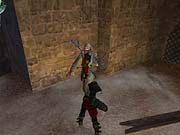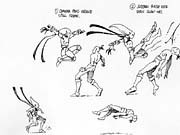Blood Omen 2 Designer Diary #2
Find out about implementing Kain's game mechanics in our exclusive developer diary.
Entry #2 - 3/13/02
By Mike Ellis
Lead Designer, Crystal Dynamics
Looking back through the history of computer and video games, there have been many cool characters. There are characters who are fun and instantly lovable, like Yoshi, who, if we ever perfect genetics in our lifetime, is our pet of choice. Then there are characters like Maximo. Always ready to hack through a legion of monsters and save the world or grab the girl. Also, let's not forget the charms of characters such as Chun Li, Lara, and Yuna (FFX).

However, just how many bad guys or "gray" characters really stand out? Kefka from Final Fantasy? Or how about Revolver Ocelot? There are good examples and great characters in what may be an underdeveloped aspect of games--characters who aren't good guys but still have depth. But even they lack one thing: player control! This is one of many aspects that make Kain such a great character. He's powerful, arrogant, calculating, and ruthless, not to mention a megalomaniac. And we, the players, get to play as him! This instantly presents an interesting dilemma to the development team. How do we take a character already as powerful as Kain is from LOK: Blood Omen and let him grow? Which mechanics would successfully cross over from a 2D game (LOK: BO) played from an overhead viewpoint to a fully realized 3D world? We also had to examine the style and pacing of the gameplay that we wanted. This raised questions such as "How many people have played and remember LOK: Blood Omen?" and "To just how many people does Legacy of Kain mean Soul Reaver?" What would each of these audiences expect?
With the creation of the Sarafan Lord and the concept of him having lead the reformed Sarafan armies to victory over Kain's vampire hordes, we could address the balance of the world a little and create a foe worthy of Kain. However, it was the idea of the Sarafan Lord leaving Kain for dead and claiming the Soul Reaver as his own that solved many design problems. The most powerful weapon in the LOK universe wasn't freely available, and Kain now had a very personal and driving purpose--retrieve the Reaver and settle his score with the Sarafan Lord!
Kain's near-death experience and a 200-year hibernationlike period also provided us with a reason why Kain didn't retain all of his original powers--and it helped with issues such as the look and feel of the world, as well as player training. However, throughout this process of setting up the state of the Nosgoth at the opening of play, it was essential that we remembered that people wanted to play Kain, since he was powerful and ruthless. Thus, he still needed to retain these character traits. This is where the unfortunate population of the city of Meridian came in. It had already been decided that we wanted to portray a busy fantasy-world city at night, and these poor wretches were the perfect tool to demonstrate just how frightening and powerful Kain was. They would run, trip, cower, and scream! Back away from Kain in fear and beg for their worthless lives! Kain would manipulate the humans as if they weighted nothing to him, as well as stalk his prey like the most cunning of lion. We would see if their Sarafan could protect them from this creature of the night!

Beyond Kain's physical abilities, it was obvious that he would need more to defeat those who had overcome his hordes. The Soul Reaver games had established that vampirish powers could be taken from the fallen by the victor. Thus the concept of "dark gifts" was born. Dark gifts would be those extra-special powers that let Kain perform amazing feats--but these powers had to be gained first.
At the beginning of the game, we attempted to lay down guideline and rule sets for each of the dark gifts. However, changing prototyping platform from PS to PC, as well as the strains of constructing a new engine along with a game, meant that we couldn't always stick to the ideal of prototyping a mechanic, tuning and playing with it, and then building the levels to take maximum advantage of it. Because of this, we ended up having to change some of the level geometry multiple times as mechanics were proven, evolved, or tuned. Looking back, the mechanics that worked the best where those that were implemented earliest, as we had the most time to play with them.
Developing mechanics is never an easy task. Sometimes the best ideas turn out to be unusable, as they break the world's mechanics or stylistics. Sometimes they just don't turn out the way you expect. Other times, something unexpected turns out to be far cooler than previously thought--all thanks to the talent of a particular team member or two.

A good example of how mechanics were implemented would be the dark gift "jump." The concept was to let Kain bound from rooftop to rooftop with ease. First we began to prototype, producing basic animation and implementing the controls, all based upon estimated specifications. We quickly discovered that given the enormous distance that Kain could cover with this gift, it was very difficult to tell where he would be landing. Therefore, to prevent frustration, we let Kain jump only if we knew he could land safely. We also found that we needed to develop a player aid that at a glance would inform the player of the distance and height of the landing zone relative to Kain's current position. The creation of a 3D cursor that showed both the arc of the jump and the point of landing meant that the player could make much more informed decisions.
At this point, the mechanics of the gift worked, but everything looked crude. So, given we had much more solid specifications (thanks to the prototyping), we could produce better-tailored and more-stylish animation and swap out the arc we were drawing for the "ghosts" of Kain's flight path, which you see in the finished product. Lastly, a member of the team had the great idea that Kain could also use this gift to attack victims. This was implemented, and we had the mechanic you see in the finished game. This cycle of prototyping, evolving, and tweaking then continues until all the mechanics are implemented. The tuning is a constant process that never stops until the product ships.
Got a news tip or want to contact us directly? Email news@gamespot.com
Join the conversation